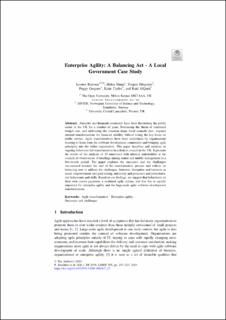| dc.contributor.author | Barroca, Leonor | |
| dc.contributor.author | Sharp, Helen | |
| dc.contributor.author | Dingsøyr, Torgeir | |
| dc.contributor.author | Gregory, Peggy | |
| dc.contributor.author | Taylor, Katie | |
| dc.contributor.author | AlQaisi, Raid | |
| dc.date.accessioned | 2020-03-18T09:59:25Z | |
| dc.date.available | 2020-03-18T09:59:25Z | |
| dc.date.created | 2019-08-01T13:52:12Z | |
| dc.date.issued | 2019 | |
| dc.identifier.citation | Lecture Notes in Business Information Processing. 2019, 355 207-223. | nb_NO |
| dc.identifier.issn | 1865-1348 | |
| dc.identifier.uri | http://hdl.handle.net/11250/2647341 | |
| dc.description.abstract | Austerity and financial constraints have been threatening the public sector in the UK for a number of years. Foreseeing the threat of continued budget cuts, and addressing the situation many local councils face, requires internal transformations for financial stability without losing the key focus on public service. Agile transformations have been undertaken by organisations wanting to learn from the software development community and bringing agile principles into the wider organisation. This paper describes and analyses an ongoing behaviour-led transformation in a district council in the UK. It presents the results of the analysis of 19 interviews with internal stakeholders at the council, of observations of meetings among senior and middle management in a five-month period. The paper explores the successes and the challenges encountered towards the end of the transformation process and reflects on balancing acts to address the challenges, between: disruption and business as usual, empowerment and goal setting, autonomy and processes and procedures, and behaviours and skills. Based on our findings, we suggest that behaviours on their own cannot guarantee a sustained agile culture, and that this is equally important for enterprise agility and for large-scale agile software development transformations. | nb_NO |
| dc.language.iso | eng | nb_NO |
| dc.publisher | Springer | nb_NO |
| dc.rights | Navngivelse 4.0 Internasjonal | * |
| dc.rights.uri | http://creativecommons.org/licenses/by/4.0/deed.no | * |
| dc.title | Enterprise Agility: A Balancing Act - A Local Government Case Study | nb_NO |
| dc.type | Journal article | nb_NO |
| dc.type | Peer reviewed | nb_NO |
| dc.description.version | publishedVersion | nb_NO |
| dc.rights.holder | © The Author(s) 2019 This chapter is licensed under the terms of the Creative Commons Attribution 4.0 International License (http://creativecommons.org/licenses/by/4.0/), which permits use, sharing, adaptation, distribution and reproduction in any medium or format, as long as you give appropriate credit to the original author(s) and the source, provide a link to the Creative Commons license and indicate if changes were made. The images or other third party material in this chapter are included in the chapter's Creative Commons license, unless indicated otherwise in a credit line to the material. If material is not included in the chapter's Creative Commons license and your intended use is not permitted by statutory regulation or exceeds the permitted use, you will need to obtain permission directly from the copyright holder. | nb_NO |
| dc.subject.nsi | Agile transformation | nb_NO |
| dc.subject.nsi | Enterprise agility | nb_NO |
| dc.source.pagenumber | 207-223 | nb_NO |
| dc.source.volume | 355 | nb_NO |
| dc.source.journal | Lecture Notes in Business Information Processing | nb_NO |
| dc.identifier.doi | 10.1007/978-3-030-19034-7_13 | |
| dc.identifier.cristin | 1713673 | |
| cristin.unitcode | 7401,90,13,0 | |
| cristin.unitname | Software Engineering, Safety and Security | |
| cristin.ispublished | true | |
| cristin.fulltext | original | |
| cristin.qualitycode | 1 | |

